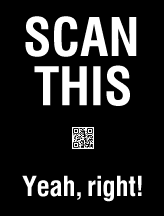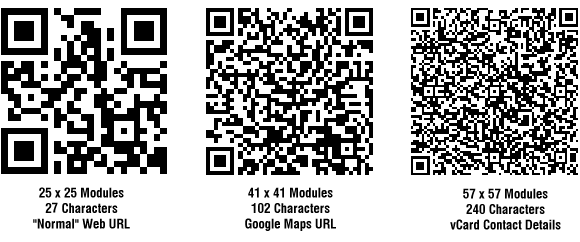 In my previous post, What Size Should A Printed QR Code Be, I mentioned that it wasn’t the size of the QR code image that determined the minimum size at which a QR code could be scanned, it was actually the size of the modules (the little black squares) that make up the QR code image. If the size of the modules fall below the resolution limit of the camera then the QR code won’t be able to be read by the device.
In my previous post, What Size Should A Printed QR Code Be, I mentioned that it wasn’t the size of the QR code image that determined the minimum size at which a QR code could be scanned, it was actually the size of the modules (the little black squares) that make up the QR code image. If the size of the modules fall below the resolution limit of the camera then the QR code won’t be able to be read by the device.
A fundamental part of the way QR codes work is that the more data you put into them, the more rows and columns of modules will be introduced into the QR code to compensate for the increased data load. Hence, for a QR code image of a certain size (width), the more data it contains, the more rows and columns of modules it has and, logically, the smaller each of the modules then become as a result.
So it’s all about whether the camera can actually “see” the smallest element in the QR image – the individual modules.
Another factor that influences minimum QR code size is the scanning distance – the distance the phone is held away from the QR code image. The further away the QR code is, the smaller it appears in the camera viewport, and so the smaller the modules will appear too. Once again, if the camera is held too far away, the modules become too small for the camera to read and the QR code won’t work.
The following table shows the theoretical minimum width of a printed QR code image for a given scanning distance, based on the minimum size an individual module needs to be when viewed by the camera. The assumptions here are that an 3-4 megapixel camera is being used (lower resolution cameras would need the QR code image to be even larger to “see” it), and a black QR code on a white background is being used.
The data shown is:
- Modules: Number of rows and columns of little black squares in the QR code image.
- Characters: Approximate number of characters that would normally fit into a QR code with that many modules using binary data encoding (most do) and Level L error correction.
- Scan Distance: The distance the camera is being held away from the printed QR code.
So for instance, a QR code image with 72 characters of data would end up with 35 rows and columns of modules, and would need to be 42mm (1.7″) wide to be successfully scanned from 300mm (12″) away, but only 21mm (0.8″) wide if the scanning device was only 150mm (6″) away.
| QR Code Minimum Size | ||||
| Modules | Characters | Scan Distance | ||
| 150mm (6″) | 300mm (12″) | 450mm (18″) | ||
| 25 | 26 | 15mm (0.6″) | 30mm (1.2″) | 46mm (1.8″) |
| 30 | 49 | 18mm (0.7″) | 36mm (1.4″) | 55mm (2.1″) |
| 35 | 72 | 21mm (0.8″) | 42mm (1.7″) | 64mm (2.5″) |
| 40 | 98 | 24mm (0.9″) | 48mm (1.9″) | 73mm (2.9″) |
| 45 | 125 | 27mm (1.1″) | 54mm (2.1″) | 82mm (3.2″) |
| 50 | 163 | 30mm (1.2″) | 60mm (2.4″) | 91mm (3.6″) |
| 55 | 203 | 33mm (1.3″) | 66mm (2.6″) | 100mm (3.9″) |
| 60 | 249 | 36mm (1.4″) | 72mm (2.8″) | 109mm (4.3″) |
| 65 | 298 | 39mm (1.5″) | 78mm (3.1″) | 118mm (4.7″) |
| 70 | 351 | 42mm (1.7″) | 84mm (3.3″) | 127mm (5.0″) |
| 75 | 407 | 45mm (1.8″) | 90mm (3.5″) | 137mm (5.4″) |
| 80 | 468 | 48mm (1.9″) | 96mm (3.8″) | 146mm (5.7″) |
| 85 | 534 | 51mm (2.0″) | 102mm (4.0″) | 155mm (6.1″) |
| 90 | 601 | 54mm (2.1″) | 108mm (4.3″) | 164mm (6.4″) |
| 95 | 669 | 57mm (2.2″) | 114mm (4.5″) | 173mm (6.8″) |
| 100 | 739 | 60mm (2.4″) | 120mm (4.7″) | 182mm (7.2″) |
Here’s a few examples to give you an idea of what QR codes look like as their data load gets higher, resulting in the modules getting smaller and the QR code image becoming more dense.

Subscribers Get More QR Stuff!
Become a QR Stuff paid subscriber and get unlimited QR codes, unlimited scans, analytics reporting, editable dynamic QR codes, high resolution and vector QR code images, batch processing, password-protected QR codes, QR code styling, QR code pausing and scheduling and more, for one low subscription fee.
Full subscriptions start from just $11.95 for a 1 month subscription (lower monthly rates for longer periods) or you can set up a 24 hour trial subscription for $3.95 to check out what we can do for you. Subscribe now.







Hilla Rosenberg,
Content Writer at QRStuff
Hilla is a seasoned content writer at QRStuff, passionate about making tech accessible and engaging. With a knack for breaking down complex topics, she helps businesses and individuals make the most of QR Code technology.